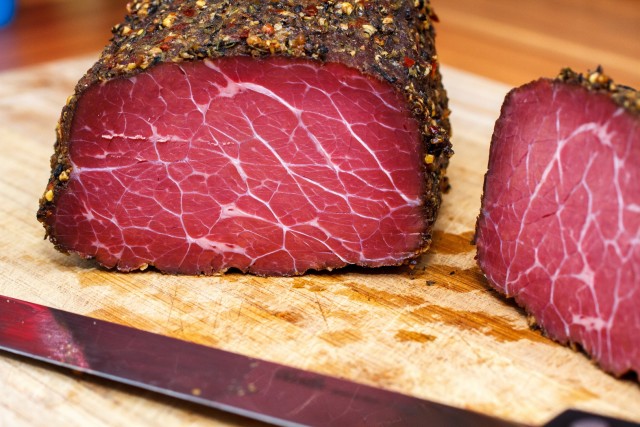Pastrami is one of the essential staples of New York deli food — an authentic pastrami sandwich is a must-have for any foodie visiting the city. However, aside from the sandwich known to New Yorkers, there are many dishes that can be prepared with this most delicious of cold cuts. However, few are familiar with pastrami’s connection with Bessarabia.
My own favorite Jewish dish in Bessarabia is, without a doubt, pastrami, or in its Bessarabian pronunciation, “pastrama.” Much as forshmak is a symbolic dish for Ukrainian Jews, pastrama is an iconic symbol of Jewish culture in Moldova and Romania. There are differing historical accounts of the history of the dish as well as it’s origins, all deserving of exploration.
One widespread explanation finds pastrami’s origins in the Ottoman Empire in the 13th century, in the town of Pastirma in eastern Turkey. There, horsemen stored tough cuts of sheep or goat meat under their saddles so that over the course of a hard day’s ride, they would tenderize and take on the salty flavor of horse sweat. Appetizing, to be sure. When cooks learned to simulate the same effect in the kitchen, pastirma was born. (In Turkish, pastirma means “to press.”)
Another line of thought claims that pastrami originates from the Armenian word basturma — air-dried highly seasoned meat with a thick crust made of spices. This seems to be supported by the number of Armenians who settled in Bessarabia, along well-tread trade routes.
Pastrami even appears in cultural artifacts of early 20th century Bessarabia. In Aaron Lebedeff’s “Romania, Romania,” an ode to the country’s prewar glory, pastrami finds itself in good company among other culinary staples:
Once there was a land, sweet and fine.
To live there is a pleasure;
What your heart desires you can get;
A mamalige, a pastrami, a karnatzl,
And a glass of wine, aha …!
However, looking to these pastirma and basturma, we see that these are both dried or cured meats, yet pastrama is not a dried meat at all! All they share is a name — pastrami, pastrama and basturma likely have the same root.
So, allow me dear reader to offer up another hypothesis. The idea of pastrama was a clever combination of two recipes: A baked meat similar to roast beef, popular in Eastern Europe, known in Ukraine as buzhenina, combined with Turkish pastirma.
Buzhenina is most frequently made with pork, and is of course not kosher. Jews in Ukraine mostly typically substituted beef for pork. But beef, especially cheap cuts, is often tough and gristly. In order to tenderize the meat, it was marinated, sometimes for as long as a week or more. After that, the beef was baked or smoked. Like pastrami, buzhenina was mostly served cold (more convenient in the era of the wood-burning stove) and eaten like a sandwich or with different garnishes. It made for a comparably inexpensive meat dish that was easy to prepare and was not quick to spoil — convenient, and suitable to celebrate Shabbat!
Jews in Bessarabia started to call this dish “pastrami” instead of buzhenina. For this, I do not have an explanation, merely conjecture. Perhaps, this served to distinguish pork buzhenina from kosher beef pastrami. Perhaps there were other reasons. The word “pastrami” may have come into use in Bessarabia because of the region’s proximity with the Ottoman Empire, or familiarity with Armenian basturma which is still available in local markets today.
In the late decades of the 19th century, family recipes for pastrami were carried by Jewish immigrants to New York, where this dish found a new life in America. From there, as they say, the rest is history.
Dmytro Sikorsky is a restaurateur, scholar and historian of the Odessa and Bessarabia region.




































